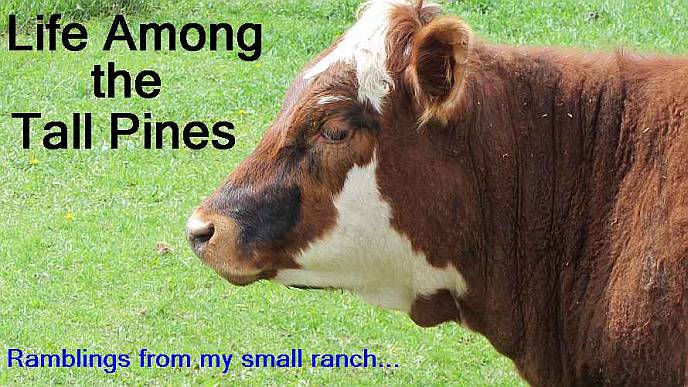After I had removed the net-wrap from the baler's roller last Tuesday, and as I started to bale, I noticed my baler had trouble baling the hay. The baler would slow down as if the hay was coming in too fast. Therefore I had to drive in the lowest gear to move slower. Also, I usually bale at 20 to 22 rpm. I now ran at 24 to 25 rpm to make the engine speed and baler rotation faster.
I was able to make two bales successfully, though slowly. On the third bale, when the baler reached "60" it would then start the net-wrap. The feeding of hay was slow and the baler was slowing down off-and-on. I wasn't sure the baler spun enough for the entire bale to be net-wrapped. So I then used the baler's monitor to again net-wrap the bale. When I unloaded the bale I found only part of the bale was net-wrapped and the bale, as it rolled out of the baler, partially unrolled. Great. Just great.
I continued on to make another bale. But the baler struggled to turn as it started to make another bale. I had to unload that small bale and was unable to net-wrap it.
During my second hay cutting in 2020 I had a PTO clutch problem on the tractor. The John Deere dealership was able to adjust the PTO clutch back then to get the clutch back working for me, but they mentioned that in the long term I most likely would need to replace the PTO clutch. To do this they would need to split the tractor to get to the clutch and this would cost many thousands of dollars. They recommended to do this during the "off season" when they weren't so busy.
The clutch worked for me so I didn't do the repair work since then.
Okay... if my tractor's PTO clutch was messed up when the net-wrap roller wrap earlier stopped the baler's belts, let me try my older baler. It takes me more effort to use that baler, but less tractor PTO power is needed to turn that baler. Ah... but it turns out my tractor's PTO struggled to turn that empty baler.
I did notice that when my PTO was 80% to 90% engaged it had more power. Later talking to Jack at the John Deere dealership he said that is how the PTO usually works. The most power is at the 80% to 90% range, not the 100% level. So I tried to bale my hay at the 80% to 90% range. I was able to do better, but I still couldn't make a complete bale, only a small bale. And even then I couldn't net-wrap it. This partial bale I unloaded at my stack of bales outside the hay barn. Rain was in the forecast and I didn't want to unroll the partial bale. Maybe later I could lift it using my bale spear and then hand wrap some twine around the bale to hold it together.

Yes, rain was in the forecast. Maybe late Tuesday. Most likely Wednesday and Thursday. My cut hay was starting to get brown already as it has been some days since I cut the hayfield. I didn't want the hay to get soaked and have to wait many more days to bale it. I would not be baling my hay as fixing the tractor PTO clutch would take along time, especially now when the dealership repair shop is extremely busy due to all the repairs that come in since other people are doing their second hay cutting or grain harvesting now.
What am I going to do?
I need someone else to bale my hay. I asked Chris. He was busy harvesting grain, and also had 70 acres of hay to finish baling that day. If he could, he would try to help me later that day, but the odds weren't looking good.
I went around the nearby area and talked with a few other people with baled hay. I left a note on a guy's house door as I didn't have his phone number. No luck.
When talking to Chris he also asked me if I had seen a few red heifer cattle the past few weeks. A cousin of his lost a few head of cattle a few weeks ago and they were spotted heading towards the road I live next to. One of the heifers was killed when it crossed the highway. I hadn't seen the cattle but when asking about hay I also asked if the other people saw the cattle.
I had no one else at that point to ask about baling my hay but I remembered a guy down the road had some cattle. I had never talked with the guy. I decided to go ask him about the missing cattle in case they went his way. When I arrived at his place I saw he had a tractor and a large round baler. Wow.
I introduced myself, asked about the cattle (nope, he hadn't seen them), and then asked if he could bale my hay. Yes, he could. And was happy to do so. He and his wife drive by my place all the time and liked how I take care of my place. They knew me as "the rancher who rides a bicycle". I have found many people don't know my name, but they know me as a rancher and a bicyclist.
Because rain was in the forecast he came immediately to bale my hay after 8 pm. (8 pm - I had been spending hours trying to find someone who could bale my hay.) He had a big newer tractor and a new baler he bought this year. The tractor and baler were quiet when they ran. Initially I told him I told him when he was done I knew what I wanted for Christmas. Then I learned the baler cost him $70,000. Okay... maybe the baler is too expensive for my small place. It took him a few hours to bale my hay as his big machines ran and operated fast. It was dark when he was done.
So my hay was baled before it rained a little bit on Wednesday and Thursday. The guy with the new baler is a great guy and meeting him my luck went from bad to good.
 |
| You can see how long my cut hay lay there. |
Thursday late and Friday I moved the hay bales from the hayfield over to be stacked outside my hay barn.
 |
| My two small hay bales. |
The guy's new baler made the balers up to "63". My hay baler is a little off and the "60" setting makes bales around 4.5 feet wide and not 5 feet wide. The "63" setting makes bales a little over 5 feet wide. The smaller lighter bales are some of the bales I made last year. I try to feed the cattle those bales first. The smaller dark bales are bales I was able to make during the second cutting this year before my baler and tractor quit working.
I definitely have more bales that can fit in my hay shed. After I took this photo I put some of my temporary green corral panels around the hay bales. That will protect the bales later when I let the cattle back into this NE pasture to eat grass.
I am happy to finally be done with the hay cutting this year. Yesterday I spoke with the John Deere dealership about my tractor's PTO and I plan to take my tractor there next week.




























































